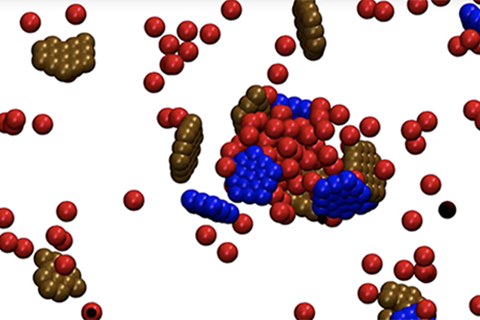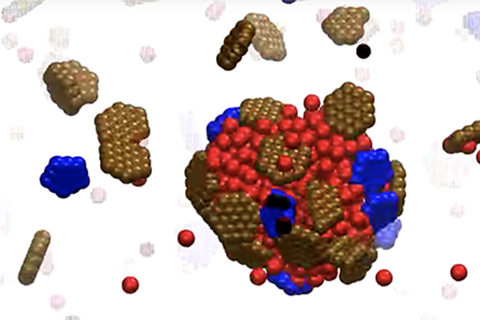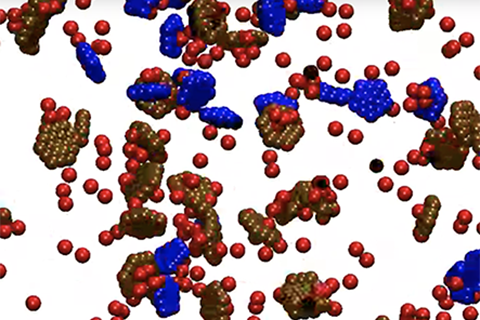Bacterial Microcompartment Assembly
Bacterial microcompartments are protein shells found in bacteria that surround enzymes and other chemicals required for certain biological reactions.
For example, the carboxysome is a type of microcompartment that enables bacteria to convert the products of photosynthesis into sugars (thus taking carbon out of the atmosphere). During the formation of a microcompartment, the outer protein shell assembles around hundreds of enzymes and chemicals required for the reaction. Because the intermediates in this assembly process are small and short-lived, it is hard to study in detail using experiments. It is therefore useful to develop computational models that can help explain how proteins collect the necessary cargo, and then assemble into an ordered shell with the cargo on the inside.
The videos on this page show some examples of computer simulations of a model for bacterial microcompartment assembly, with each video corresponding to a different set of parameters that control the strengths of interactions among the proteins and cargo. The study is described in a research article in the journal eLife by Perlmutter et al.: eLife 2016;10.7554/eLife.14078.
This video shows encapsulation of hundreds of cargo molecules by a model bacterial microcompartment. In the first step an amorphous globule of cargo molecules (red) forms, with unassembled shell subunits (hexamers (brown) and pentamers (blue)) adsorbed to it. Then two shells begin to assemble on the globule. Eventually, the curvature of the shells forces them to bud from globule, each carving out a portion of the cargo as they go. This multistep pathway is consistent with experimental observations on the assembly of a type of carboxysome called a beta-carboxysome (Cameron et al., 2013; Chen et al., 2013).
This video shows another example of a simulation in which a model bacterial microcompartment shell encapsulates hundreds of cargo molecules by a multistep assembly pathway. Shell subunits (hexamers (brown) and pentamers (blue)) are adsorbed onto the cargo globule (red) in a disordered manner. The adsorbed shell subunits collectively assemble and bud from the globule.
This video shows an example of a simulation in which a model bacterial microcompartment encapsulates hundreds of cargo molecules through a single-step assembly pathway. As the protein subunits (hexamers (brown) and pentamers (blue)) start to assemble into a shell, cargo molecules are condensed into a dense globule. This pathway is consistent with experimental observations on the assembly of a type of carboxysome called the alpha-carboxysome. (Cai et al., 2015; Iancu et al., 2010)


